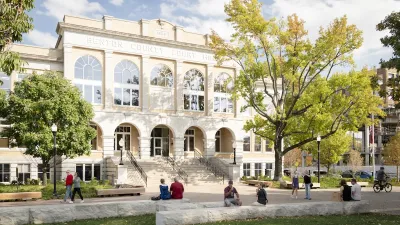Rick Jacobus looks for a way out of gentrification paralysis, and suggests that incremental improvements to lower-income neighborhoods can be a bulwark against broad displacement.
"The paralyzing thinking goes like this: We want to improve lower-income neighborhoods to make them better places for the people who live there now but anything we do to make them better places will inevitably make people with more money want to live there and this will inevitably drive up rents and prices and displace the current residents,..." explains Jacobus, director of the Cornerstone Partnership. "Once you recognize this dynamic, it is very hard to talk yourself into wholeheartedly backing any kind of action. It seems wrong to leave distressed communities to rot but it also seems wrong to turn them around."
Jacobus suggests a course of action for the lower-income communities most vulnerable to displacement: "'improvements' that make the place more attractive to slightly higher-income households may actually provide the most promising defense against gentrification."
"What is so promising about a program like the one Alan proposes, which encourages homebuyers to invest in lower-income neighborhoods along with incremental and sustained investment in things like commercial revitalization, is that these things won’t dramatically change the social character of a neighborhood overnight. And that means that the people who will choose to move in will be more likely to be people who are comfortable with the existing character of the neighborhood."
FULL STORY: It’s Not Either/Or: Neighborhood Improvement Can Prevent Gentrification

Alabama: Trump Terminates Settlements for Black Communities Harmed By Raw Sewage
Trump deemed the landmark civil rights agreement “illegal DEI and environmental justice policy.”

Planetizen Federal Action Tracker
A weekly monitor of how Trump’s orders and actions are impacting planners and planning in America.

The 120 Year Old Tiny Home Villages That Sheltered San Francisco’s Earthquake Refugees
More than a century ago, San Francisco mobilized to house thousands of residents displaced by the 1906 earthquake. Could their strategy offer a model for the present?

Ken Jennings Launches Transit Web Series
The Jeopardy champ wants you to ride public transit.

BLM To Rescind Public Lands Rule
The change will downgrade conservation, once again putting federal land at risk for mining and other extractive uses.

Indy Neighborhood Group Builds Temporary Multi-Use Path
Community members, aided in part by funding from the city, repurposed a vehicle lane to create a protected bike and pedestrian path for the summer season.
Urban Design for Planners 1: Software Tools
This six-course series explores essential urban design concepts using open source software and equips planners with the tools they need to participate fully in the urban design process.
Planning for Universal Design
Learn the tools for implementing Universal Design in planning regulations.
Clanton & Associates, Inc.
Jessamine County Fiscal Court
Institute for Housing and Urban Development Studies (IHS)
City of Grandview
Harvard GSD Executive Education
Toledo-Lucas County Plan Commissions
Salt Lake City
NYU Wagner Graduate School of Public Service





























